For cash-strapped small businesses, having a cohort of customers willing to promote your brand for free can make a huge difference.
A customer advocacy program makes it happen. It turns customers into a powerful, organic marketing asset that increases brand awareness and trust – alongside boosting sales.
In this article, you’ll learn how to create customer advocates for your small business through a customer advocacy program, as well as how to measure your success.
Key takeaways from customer advocacy
Customer advocacy turns satisfied customers into voluntary brand promoters who share authentic recommendations.
Build an advocacy program by defining goals, identifying engaged customers and reaching out with personalized messages.
Increase advocacy with exceptional customer service, loyalty programs and customer communities.
Pipedrive helps SMBs manage advocacy programs by tracking strong candidates, automating requests and accelerating workflows with AI – try it free for 14 days.
Customer advocacy meaning: Also known as client advocacy, customer advocacy is when satisfied customers actively promote your brand, products or services to others.
It’s a form of organic B2B marketing where customers share their experiences without receiving payment. Their authentic endorsement makes recommendations more credible and influential than paid advertising.
Pipedrive’s customer case studies are an example of customer advocacy in action:

Another example would be customers of a SaaS marketing agency leaving reviews on sites like Trustpilot or recommending the agency at networking events.
The advocates bring in dozens of new leads for the agency every quarter without compensation. They promote the business because they genuinely love the experience.
More client advocacy applications include:
Writing online reviews. Reviews from trusted sources influence potential customers’ purchasing decisions and improve your business’s online reputation.
Referring customers. Word-of-mouth sales referrals from trusted sources carry significant weight and can lead to higher conversion rates.
Creating user-generated content. Advocates share photos and videos of their positive experiences on social media platforms, making potential buyers more likely to consider your offering.
Participating in customer success stories. Advocates share their success stories publicly, providing social proof for potential customers.
Defending your brand. Advocates naturally support businesses they believe in during challenging times – like supply chain issues – reducing churn and increasing brand trust.
Customer advocacy programs are particularly powerful for small businesses because they require minimal investment while delivering outsized returns.
Now that you’ve got a customer advocacy definition, it’s time to learn about its benefits for your SMB.
Why is customer advocacy important for SMBs?
Customer advocacy programs help small businesses compete on tight budgets by turning satisfied customers into free marketing, expert product feedback and a high-converting sales tool.
Here are the key benefits that make advocacy so powerful for business owners behind small-scale operations:
Build customer trust and brand awareness | What it achieves: Advocates expand your reach through their personal networks at zero cost. What research shows: The vast majority (88%) of global consumers trust recommendations from people they know more than any other channel. |
Generate customer feedback | What it achieves: Advocates offer valuable insights into how you can improve your product, better meet customer needs and become more customer-centric. What research shows: A better product leads to more customers, with McKinsey finding that even a slight increase in a product’s star rating can deliver meaningful growth. |
Increase customer retention and lifetime value | What it achieves: Referred prospects share many values and behaviors as the customers referring them, meaning they could make repeat purchases and have a high customer lifetime value. What research shows: Forrester finds that the customers you acquire through referral programs are often high-value leads. |
Improve acquisition and conversion rates | What it achieves: Existing customers act as influencers for other stakeholders. What research shows: New customers consider peer recommendations one of their top five trusted sources, according to Forrester insights. Discussions with like-minded customers are one of their top three social media interactions during the buying process. |
Small businesses don’t necessarily need a large marketing budget or top sales team if they have a handful of customers who go above and beyond.
Advocates alone will help your SMB improve your product, generate new enquiries and convert prospects.
You do need advice specific to small businesses, though, which doesn’t assume you have a big team or unlimited resources. Learn how any-sized business can build a program from scratch next.
Download Your Sales and Marketing Strategy Guide
How to build a customer advocacy program
The best way to encourage reviews, word-of-mouth referrals and user-generated content is through a structured customer advocacy program.
Follow these five steps to create a program that turns happy customers into active advocates.
1. Define your advocacy goals
Start by defining what you want your advocacy program to achieve.
Clear goals help you design appropriate advocacy activities and measure the program’s success. They also prevent spreading efforts too thin and failing to drive meaningful results.
Use one of the example goals below to create your own.
Example advocacy goals:
Increase monthly customer referrals by 20%
Create 10 customer case studies each quarter
Improve NPS score by 50% next year
Generate 15 video testimonials within six months
Make sure to align advocacy goals with your broader business objectives.
So, if you’re expanding into new markets, focus on the referral aspect of an advocacy program. If customer churn is a problem, focus on improving net promoter score (NPS).
2. Identify prospective advocates
Search your customer base to find the people most likely to become brand advocates.
A strong customer advocate candidate typically has the following attributes:
Scores nine or 10 on NPS surveys
Frequently engages with your team
Has higher-than-average product or service usage levels
Achieves measurable success with your product
Shows enthusiasm when talking with your team
Your customer relationship management (CRM) system is a great way to find these individuals.
For example, Pipedrive customers can use the contacts timeline to see how often custovmers interact with your team.

If a customer frequently picks up the phone, answers your email or engages with educational content like dedicated webinars, they’ll probably make a great advocate.
Make it easier for your future self by encouraging sales reps and customer success managers to create notes in your CRM whenever a customer exhibits a desired behavior.
In Pipedrive, you can use the notes feature to flag potential advocates:
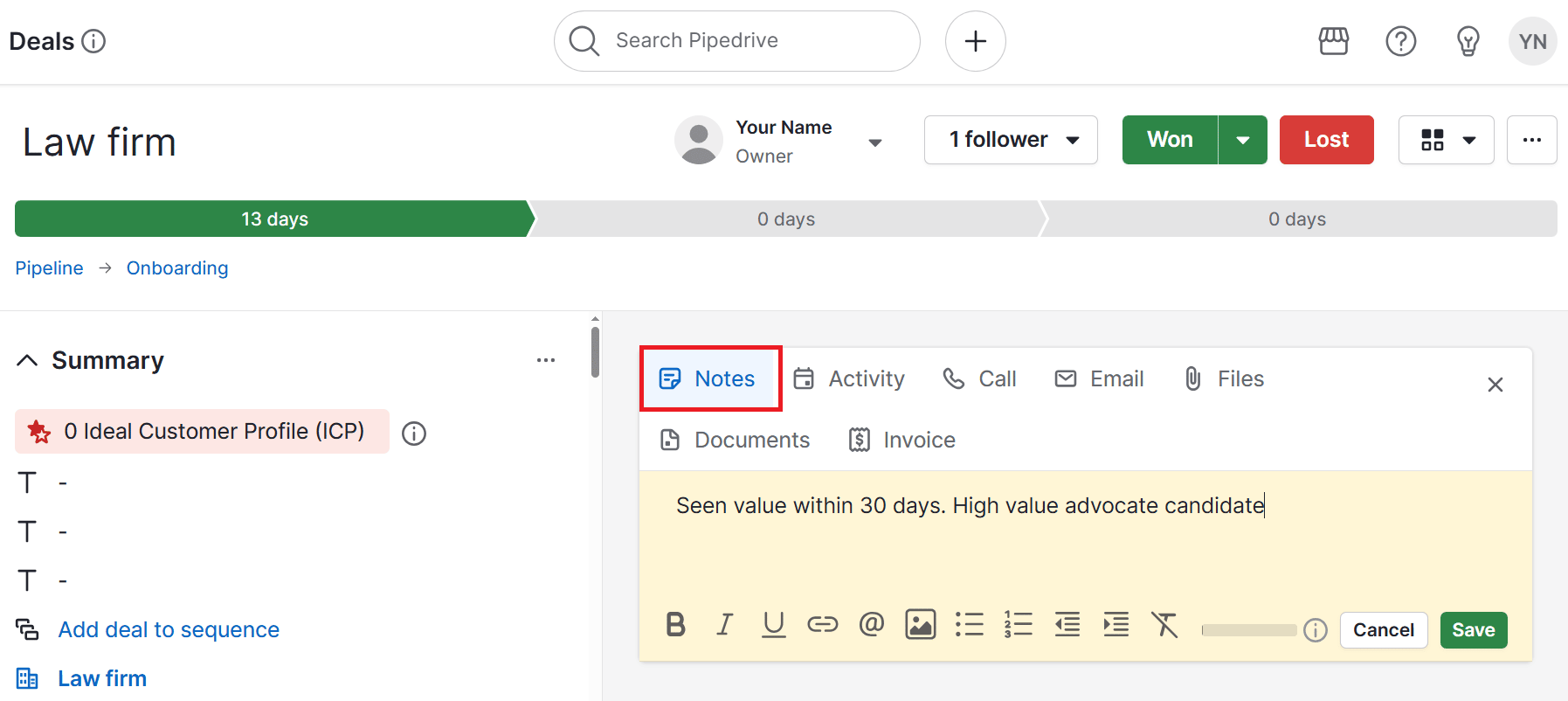
Using consistent language will make it faster and easier to search documentation for future candidates.
3. Create a personalized communication strategy
Build stronger relationships with potential advocates through a personalized outreach strategy.
Reach out using the customer touchpoints they prefer, explain why you think they’d make a great advocate and what’s in it for them.
While it’s possible to automate part of your customer advocacy program – and you’ll learn how to do so later – a personalized approach is best when building a program. Personalization makes candidates feel valued and increases the chances they will say yes.
You can accelerate the process using Pipedrive’s AI email writer to draft personalized messages:
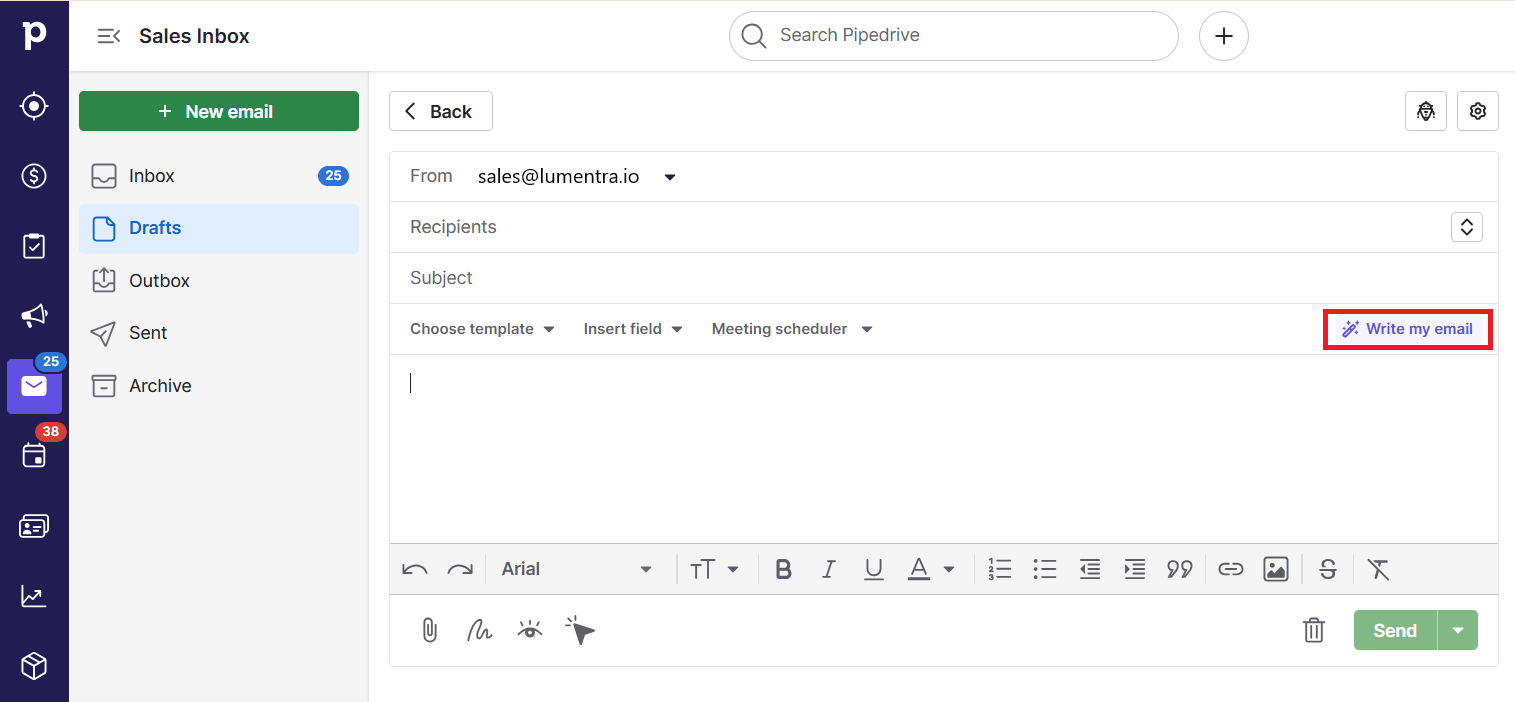
The tool analyzes customer data and previous sales activities to create contextually relevant messages with a personal touch.
The key to successful outreach is making clear what’s in it for customers. Benefits of participating in your advocacy program could include:
Early access to new features
Exclusive content or training sessions
Public recognition of their contributions
Cross-promotional opportunities
Chances to guide product development
Remember to also follow up on your initial approach.
These customers have proven levels of engagement. If they don’t respond, it’s not necessarily because they’re not interested in helping your brand. You might just need to nudge them again.
4. Choose your advocacy channels and tactics
Advocates can support the brands they love in several ways, but you’ll want to pick one or two in advance to give your initiatives focus.
Here’s a list of popular advocacy tactics:
Referral programs with incentives for successful introductions
Case study development through interviews or written submissions
User-generated content creation, like reviews and social media posts
Testimonial and review collection through automated email campaigns
Start with one or two tactics that align with your goals.
If you’re a small team, focus on a tactic that is relatively easy to implement – like creating a customer case study – rather than trying to launch a referral program from scratch.
5. Measure and iterate
Track the success of your advocacy program with marketing metrics that align with your goals.
Regular measurement helps you understand what’s working and where to invest more resources. Tracking helps you operate with full visibility and justify continued investment in advocacy activities.
Here are metrics you can use to measure your program’s success:
Advocacy metric | How to measure it |
Advocate participation rates | Track what percentage of enrolled advocates actually contribute reviews, referrals or testimonials. Low participation signals you need better incentives or simpler processes. |
Referral volume and conversion rates | Measure how many referrals advocates generate and how many convert to customers. This tracking signals advocacy’s direct revenue impact. |
Testimonial and review generation | Count the number of new reviews, testimonials and case studies you create each quarter. Set targets and celebrate when you hit them. |
Social media mentions and engagement | Track brand mentions, hashtag usage and engagement rates on advocate social media posts. Positive sentiment indicates healthy advocacy. |
Revenue attributed to advocacy activities | Calculate revenue from referred customers and track the customer lifetime value of advocate-sourced leads. Revenue indicators will demonstrate ROI to stakeholders. |
Once you’ve got your customer advocacy program in place, use the tips below to increase customer engagement.
5 proven ways to increase customer advocacy (with examples)
Your advocacy program’s success hinges on having a steady supply of happy customers willing to participate in reviews and case studies.
Use the following five tips to boost customer satisfaction levels and optimize your customer advocacy strategy.
1. Deliver exceptional customer support
Exceptional customer service creates an emotional connection that can inspire strong advocacy.
When you resolve a customer’s issues quickly and effectively, they often like your brand more than users who have never faced issues. This paradox occurs because problem resolution proves your commitment to customer success.
Here are some ways to improve customer service levels:
Employ AI-powered customer care agents that answer questions immediately and reduce wait times
Run a customer service quality assurance program to ensure your customer support meets expectations
Solve support requests across multiple platforms, including email, phone and social media
Create a knowledge base that makes it easy for customers to self-service
Another way is to manage and solve customer requests as quickly as possible.
A CRM solution like Pipedrive can be invaluable. You can use its customizable pipelines to manage customer support requests.
You might create a pipeline with the following stages:
Open tickets
In progress
With customer
Complete
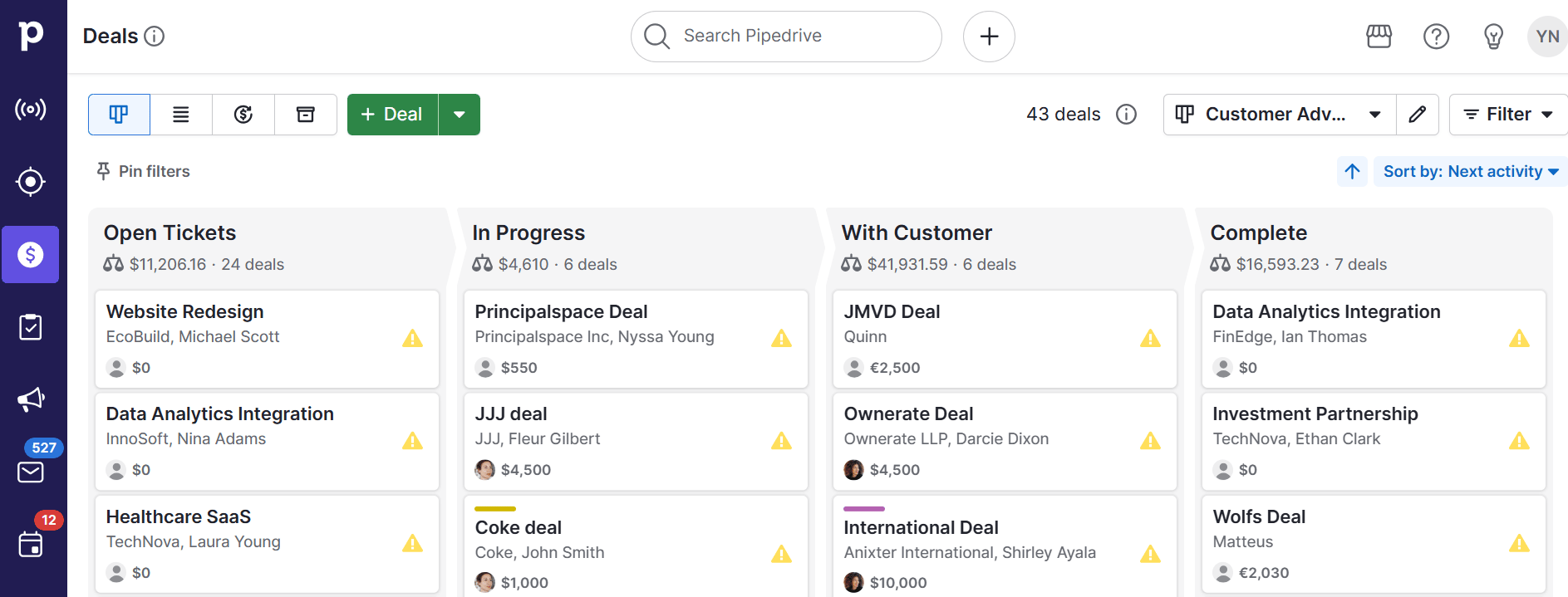
Pipedrive also integrates with customer success portals like Intercom and Crisp, so you can centralize support requests.
Explore how DashThis delivers exceptional customer service thanks to Pipedrive.
How Pipedrive Helps
DashThis, a marketing reporting dashboard platform, uses Pipedrive to manage and optimize the entire customer experience.
By integrating Pipedrive with customer service tools like Help Scout and Intercom, it tracks every interaction across the customer’s journey.
The team can see what problems users encountered in the past and the solutions provided, then adapt its response to deliver the best client service.
As founder Stéphane Guérin explains:
2. Encourage and act on customer feedback
Asking for your customers’ input on product development can increase satisfaction by making them feel heard.
It also increases advocacy opportunities. Customers are much more likely to recommend brands that take suggestions on board and implement feedback.
Start by creating multiple feedback channels, including surveys, direct outreach and web-based form submissions.
For example, productivity software provider ClickUp dedicates an entire page to product roadmap requests:
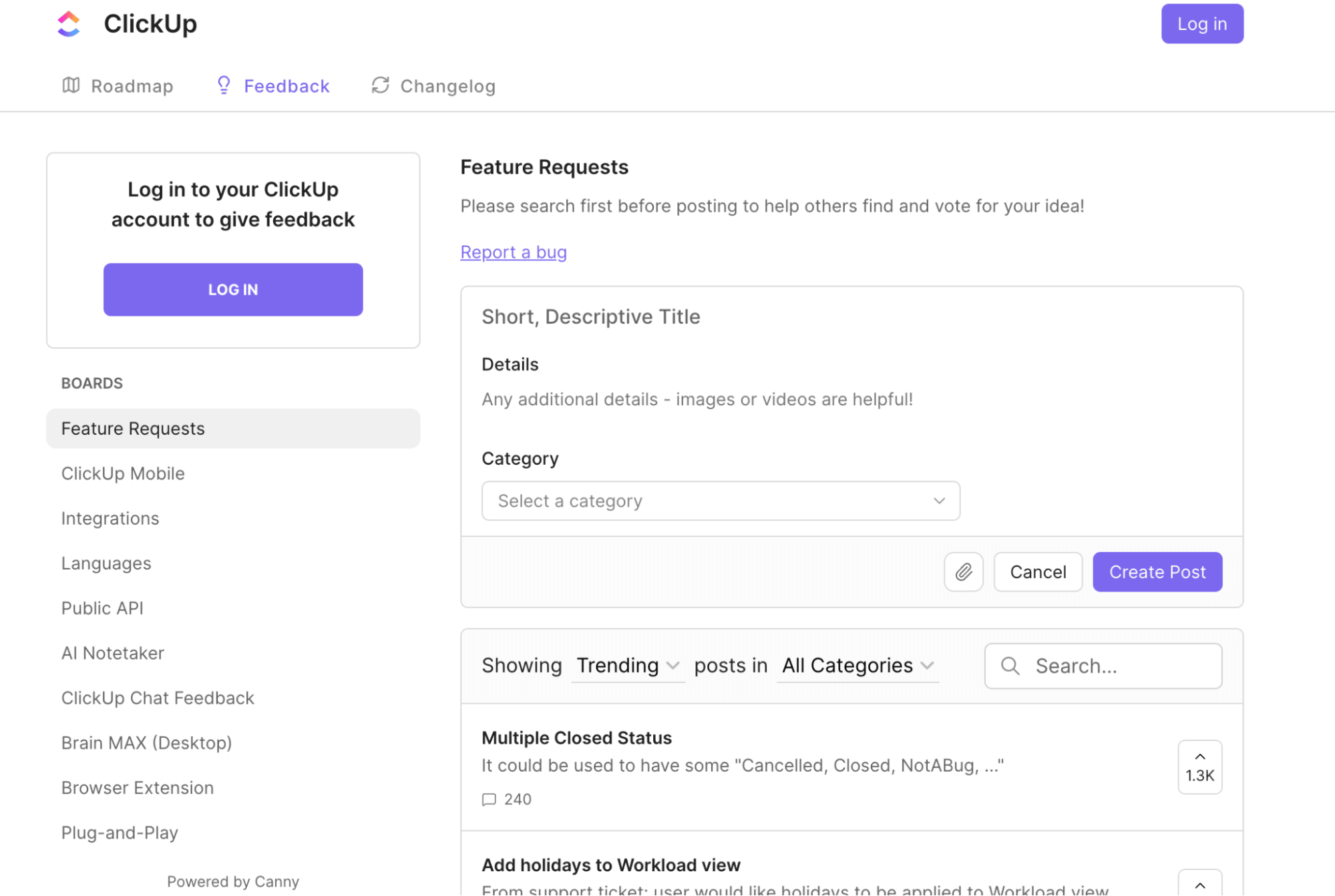
Once you’ve got requests, make them easy to track and action by recording them in your CRM.
For example, Pipedrive customers can create a custom feedback tracker like this one:
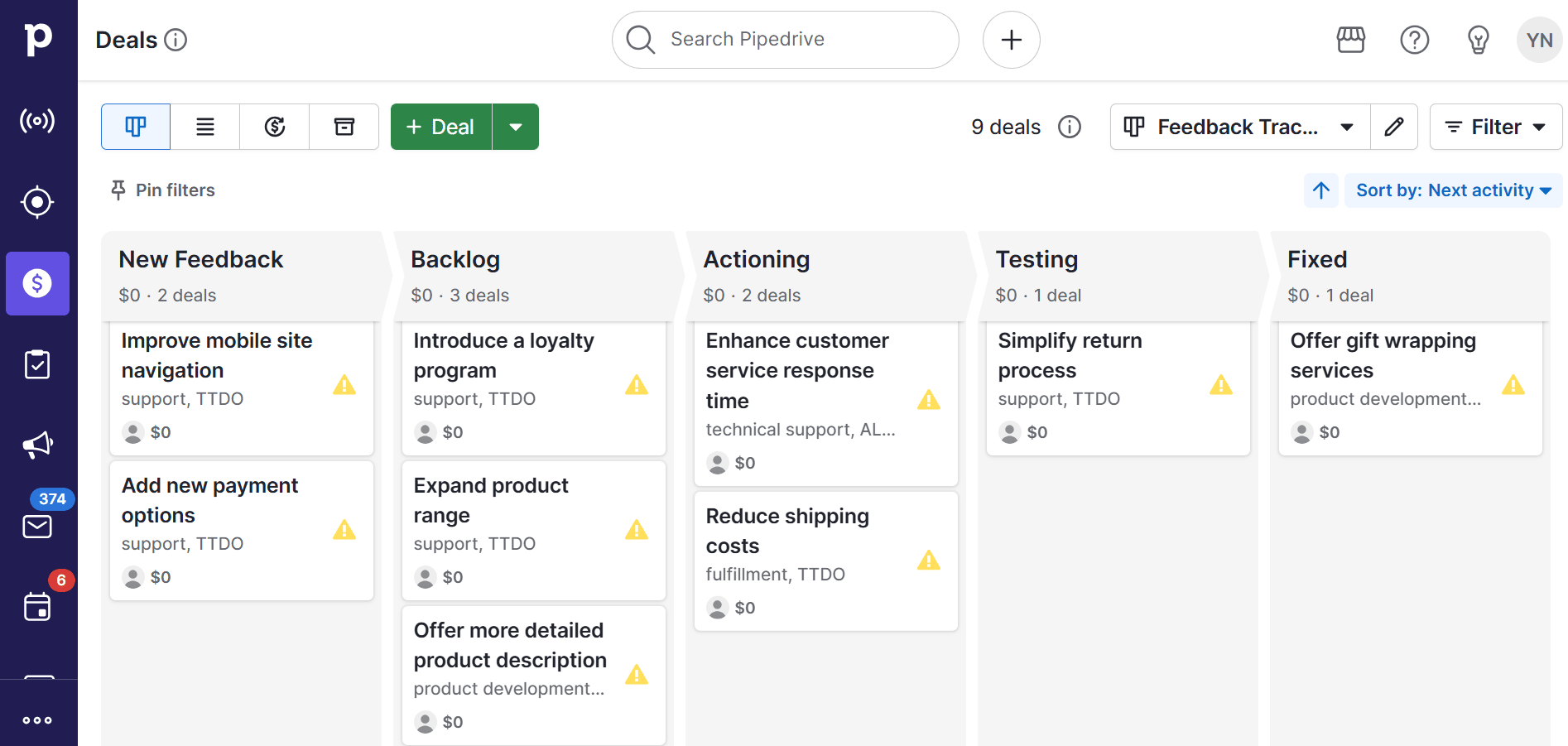
Using Pipedrive as a type of customer advocacy software in this way makes it easier to manage and prioritize requests.
When you move a customer’s request to “Fixed” or “Completed”, send them a personal note thanking them for the suggestion and notifying them it’s live.
Hint: Now is also a good opportunity to ask your satisfied customer to become an advocate.
3. Automate advocacy requests
Marketing automation software helps SMBs systematically make advocacy requests without overwhelming staff or customers.
Automated systems can trigger advocacy requests at optimal moments in the customer journey, such as:
Post-purchase satisfaction surveys
Milestone celebrations
Renewal confirmations
Support ticket resolution follow-ups
Pipedrive’s workflow automation feature lets you create sophisticated advocacy triggers through a drag-and-drop interface:

For example, you can create a trigger that sends out a personalized email template when a customer hits their one-year anniversary.
Alternatively, use Campaigns by Pipedrive to manage and send advocacy requests at scale:
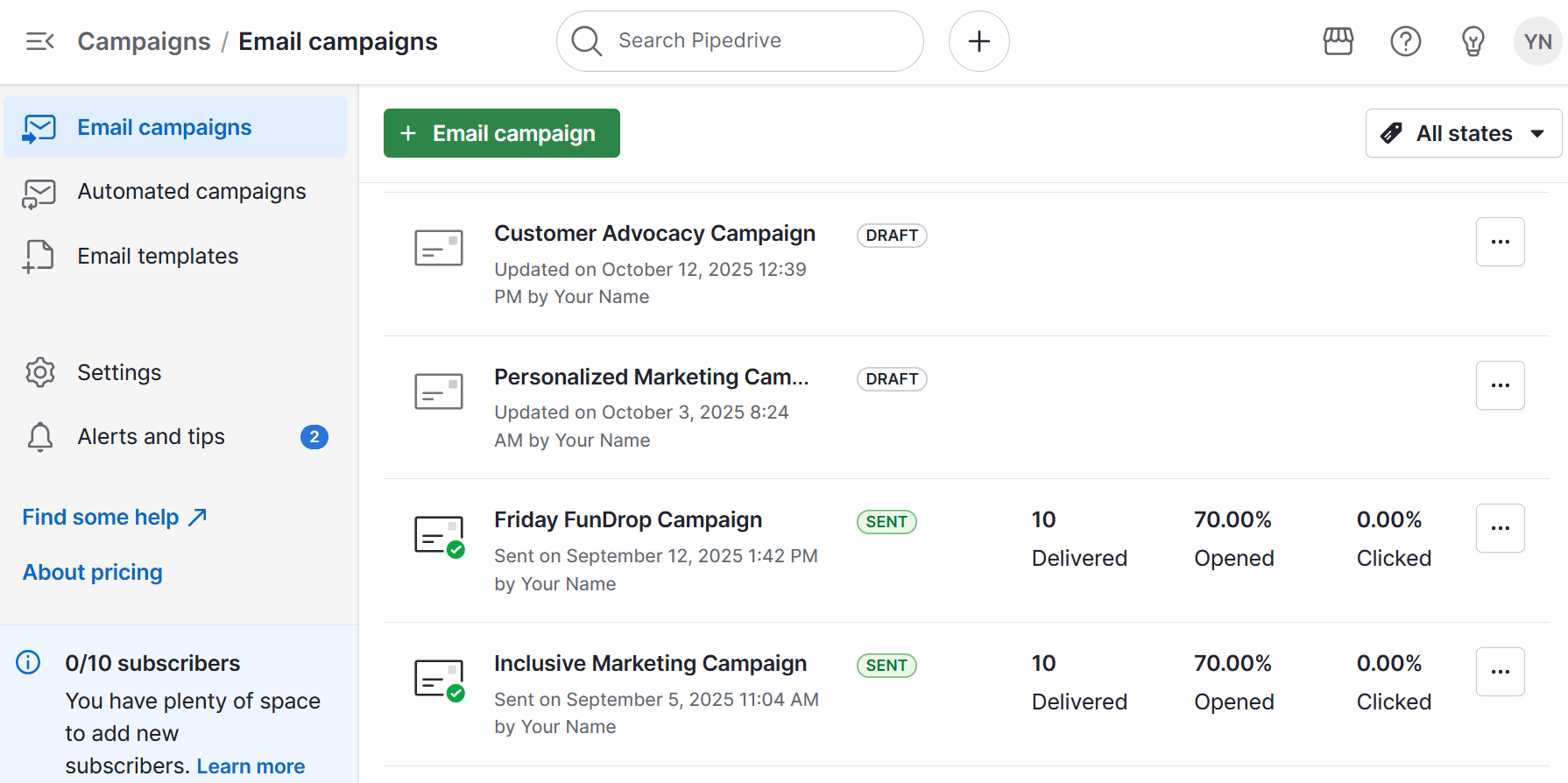
Campaigns also has a drag-and-drop builder you use to quickly create a new email template.
Once you’ve sent your campaigns, Pipedrive’s real-time reporting feature lets you track open rates, click-through rates and total clicks, so you can optimize your efforts.
4. Create a customer community
Communities deepen customer relationships, provide spaces for clients to connect and create opportunities for organic customer advocacy.
Online communities can be simple Facebook groups, forums, dedicated platforms or sections within your website.
Project management platform Monday, for example, has a subdomain that connects customers and helps them develop their skills:
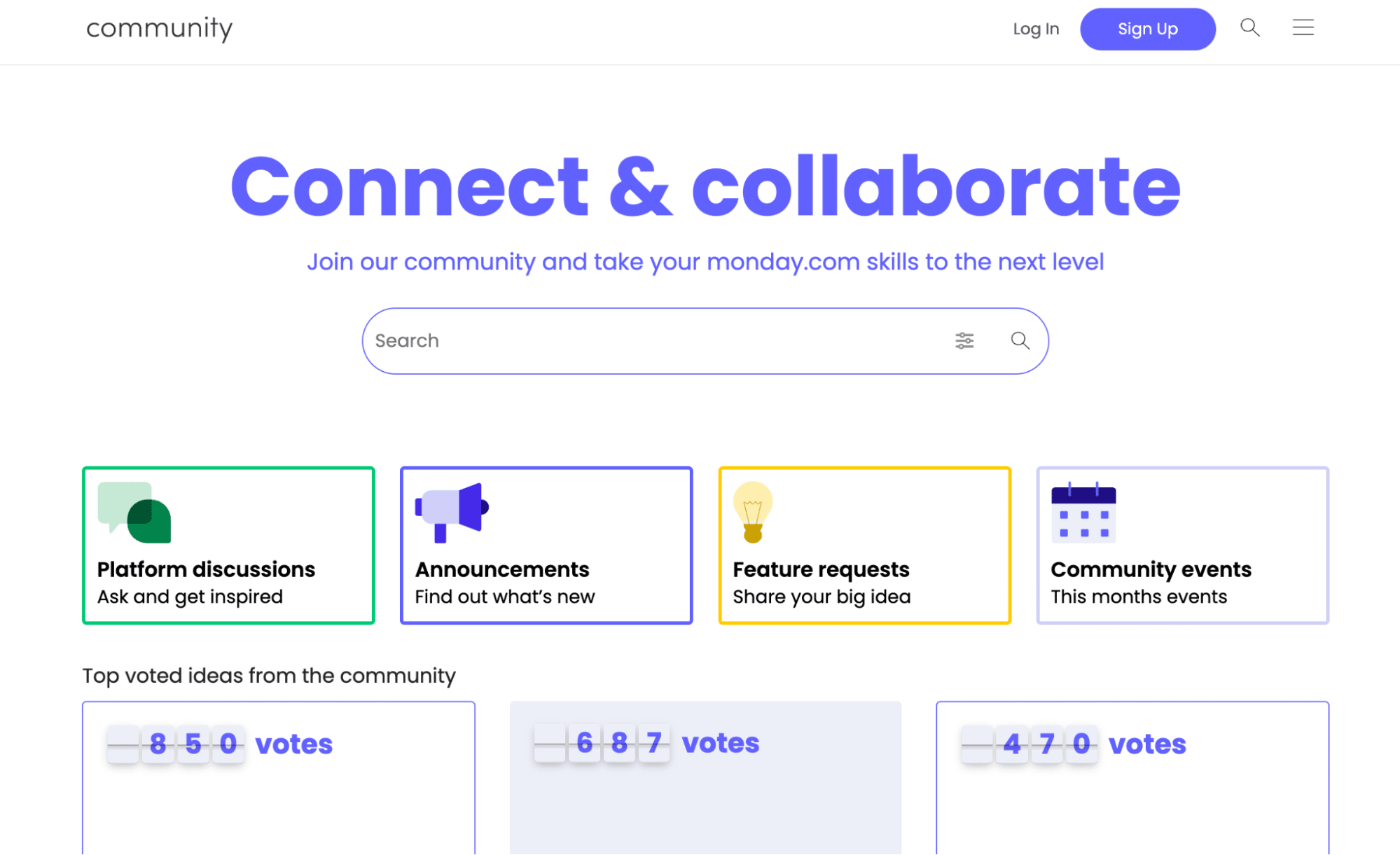
The key is creating spaces where customers feel comfortable sharing experiences and asking questions.
Here are some tips to improve your community and foster advocacy:
Encourage power users to share their top tips and best practices.
Create regular “customer spotlight” features showcasing member wins
Provide direct access to your team for questions and feedback
Offer exclusive content and early access to new features or information.
Facilitate peer-to-peer support where customers help each other
Pay close attention to the engaged members of your community. Active community users often become your most vocal advocates because they feel connected to your brand and other customers.
5. Incentivize advocacy through loyalty programs
Well-designed brand loyalty programs encourage repeat business while creating advocacy opportunities.
Additional support, branded assets and non-monetary rewards may be all existing customers need to promote your product to their peers.
For example, Pipedrive offers several partnership opportunities for businesses that promote its products:
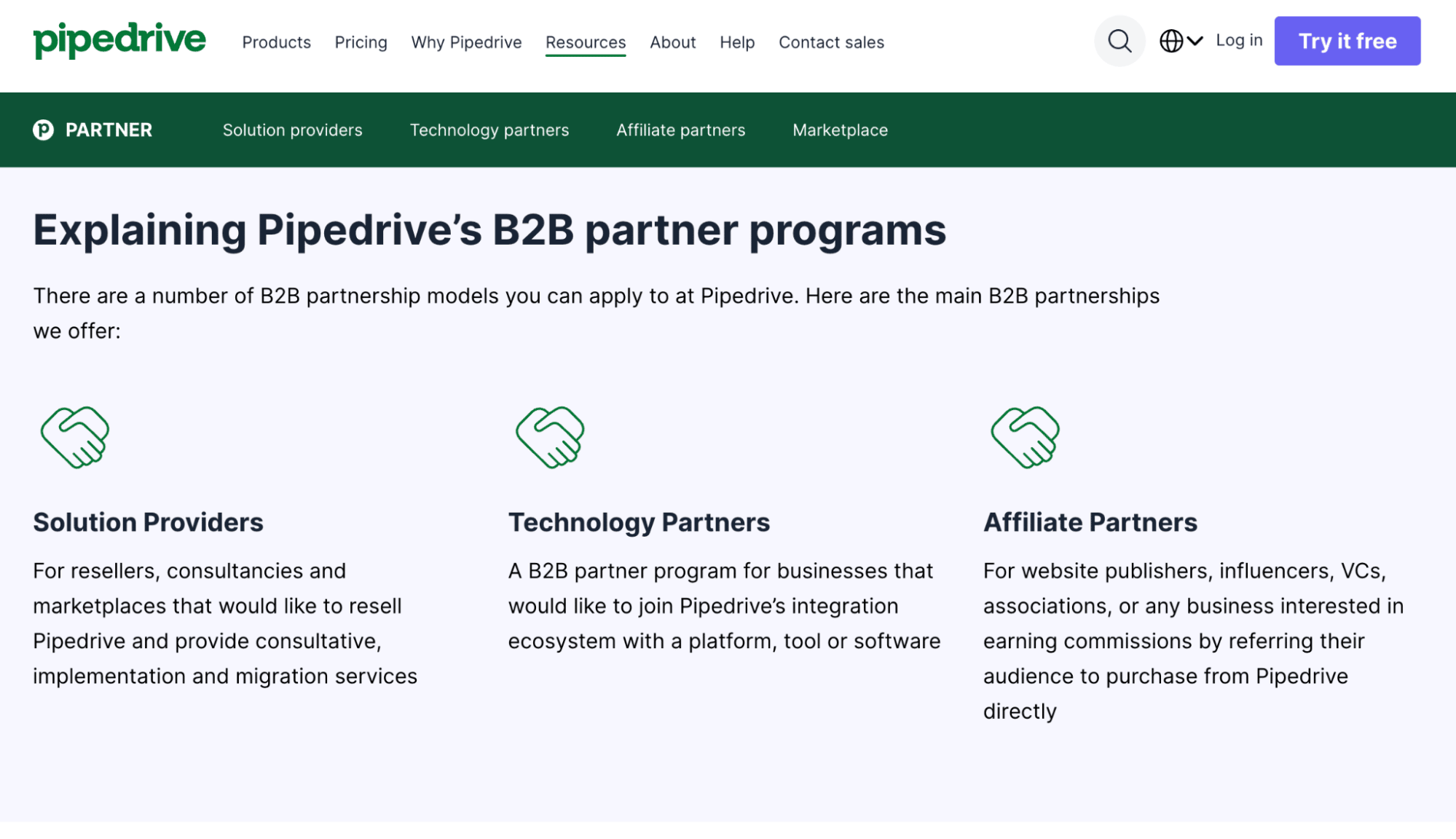
Here are some ideas for driving advocacy through a loyalty program:
Provide subscription discounts and other benefits when clients refer others who become paying customers
Offer special perks like extended trials, premium features or exclusive content to customers who contribute advocacy content
Create bronze, silver and gold tiers based on combined purchase and advocacy behavior, with higher tiers unlocking better perks
Give loyalty members first access to product launches, new features or limited offerings
Track advocacy-driven revenue by tagging deals with their source in your CRM system. The data will let you know which type of partnerships work best and how you can drive better results going forward.
Of course, it’s also important to track customer advocacy success as a whole. You’ll learn how to do that next.
How small businesses can measure customer advocacy
Measuring customer advocacy helps you demonstrate your program’s value, optimize your efforts and improve your success.
While there isn’t a single customer advocacy metric, you can gauge your progress using one or more of the key performance indicators (KPIs) below:
Key performance indicator | What it measures and how to use it |
Net promoter score (NPS) |
|
Customer satisfaction score (CSAT) |
|
Customer lifetime value (CLV) |
|
|
Net promoter surveys will be the easiest and cheapest way for SMBs to measure advocacy. You only need to ask customers a single question: How likely are you to recommend [your company] to a friend?
Categorize responses in the following ways:
9–10 – promoters
7–8 – passives
0–6 – detractors
Your NPS is the percentage of promoters minus the percentage of detractors.
Imagine you survey 100 customers. If 40 of them score 9 or 10, 40 of them score 7–8 and 20 of them score between 0–6, you have an NPS of 20.
Use a tool like SurveySparrow or NativeForms to get started. If you’re a Pipedrive customer, both platforms integrate with your CRM so you can create surveys and track responses in one place.
Here’s what an NPS survey from SurveySparrow looks like:
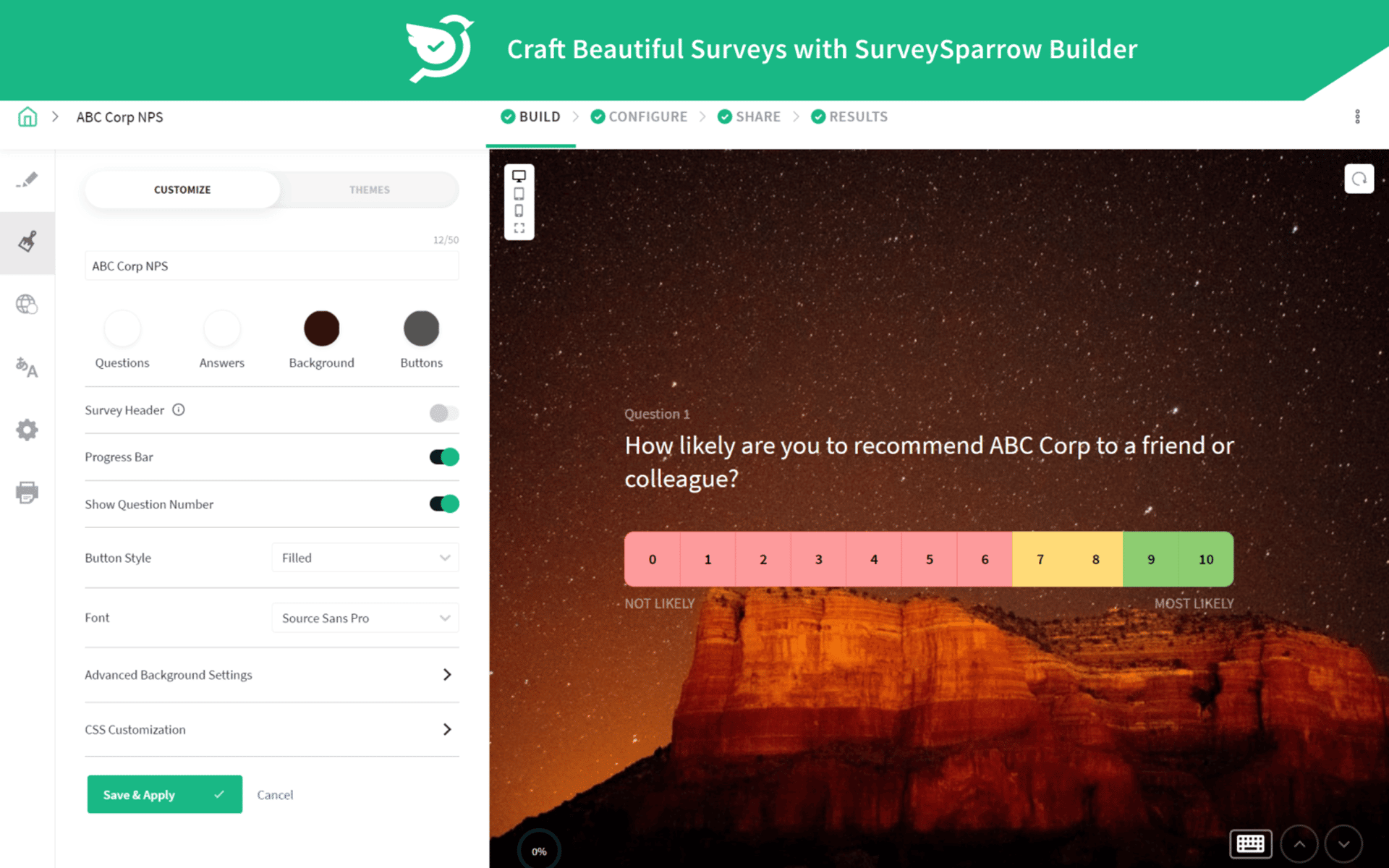
When you’re ready, supplement NPS scores with more in-depth customer surveys or data from social listening tools.
Final thoughts
Customer advocacy is a powerful marketing strategy for small businesses that increases reach without requiring a large upfront investment.
All you need is happy customers and a way to reach them.
Unlike enterprise-focused advocacy software, Pipedrive gives small teams automation, visibility and outreach in one place. Start a 14-day free trial to see how its CRM, AI and automated workflow features boost your customer advocacy efforts.








